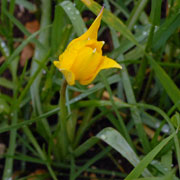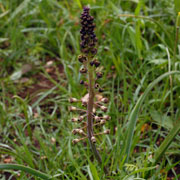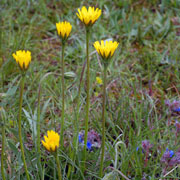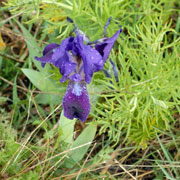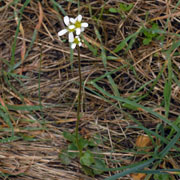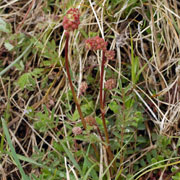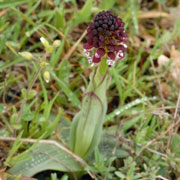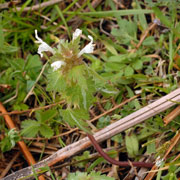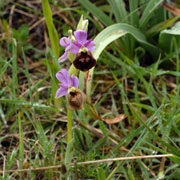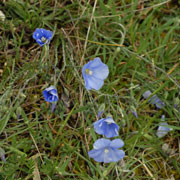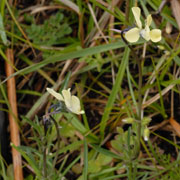Today the weather would be different. My family have never experienced persistent, cold, gloomy weather in the Mediterranean before and on the one occasion in Spain decades ago when we enjoyed a spectacular thunderstorm, the hot summer sun soon vapourised the clouds and we reached for the sun screen again. Winding back the shutters today I thought I must have gone blind. There was no view. Even the rails surrounding the small balcony were grey, blurred and indistinct. The hotel was surrounded by dense cloud with outside objects dripping with condensation. The temperature had gone down from the balmy 9 Celsius of yesterday and was roughly about the February average for Oban (Scotland). Still we're British. A bit of bad weather doesn't lower our spirits does it? It'll brighten up later won't it? We don our vests, pullovers, extra socks, fleeces and set off for breakfast in the basement.
Breakfast: Something has to be mentioned about breakfast which was served in recently decorated dungeon two floors below the hotel foyer. The room was always cold and the same translucently thin ham and cheese accompanied by some small oval cereal things and a plate of croissant, appeared each day. Butter was available in those motorway service station brickettes. At that temperature the butter had the consistency of potter's clay so people didn't know whether to attempt spreading it onto a croissant or make a small sculpture.
I wondered if we should smuggle out some butter modules and take them to bed with us so they would be pliable for breakfast the next morning.
Luke warm coffee was on offer and one or two brave souls attempted a tea ritual.
Have you ever tried making tea with luke warm water? It can be done but has a parallel with boiling eggs at base camp on Mount Everest: possible but inadvisable. Had we been incarcerated in a British penal establishment, the repetitive nature of the fare and the permanent low temperature would have possibly breached our human rights.
Still I keep being told to be more positive so here goes: the breakfast-room temperature meant there were no snakes, scorpions or flies and we were too far south to be bothered by Polar bears. Also the food was kept fresh as it was permanently refrigerated.
Stop 1 and 2 En Route to the Bosco Quarto Forest
The fog had lifted by the end of breakfast to reveal another grey day. We piled into the two vans to make a short journey to our first stop. Before that though we scanned some arable fields for the possibility of wild tulips which were reputed to have been found commonly in the lower valley in the past. To me there seemed little chance as the agrochemical industry provides farmers with sufficient deadly sprays to keep field that uniform green we've become used to in Britain. But wild tulips are much hardier than I'd thought - they were dotted throughout the crops and we went to take photos. The yellow Tulipa sylvestris (Wild Tulip) and Bellevalia dubia (Bellevalia) were the two plants we found at this unscheduled stop after which we stopped by un unimproved hillside to find look for flowers.
At the second stop of the day we soon we found the yellow composite Scorzonera villosa (Viper's grass) and yet more Orchids. For me this was quite special for although I've been botanising for years, I've never actually seen Burnt Tip Orchid and there it was. Orchis ustulata (Burnt-tip Orchid) is quite small and each small floret is spotted with pinks dots looking as though it has been designed by Laura Ashley.
The other significant Orchid was Ophrys biscutella (Spectacled Ophrys). Scutella comes from the Latin for small plate or salver and the bi-scutella refers to the small patches on either side of the lower lip or labellum. So Spectacled Orchid is perhaps one of those unnecessary concessions to modern experience and anyway Small Double Salver Orchid is a bit of a mouthful. This is quite a colourful orchid bearing in mind the interesting but rather dull dark ones: O. garganica, O. promontori and O. bertolonii we saw yesterday. We also found another Iris. Iris lutescens (No English name) is mostly blue but can also be pale yellow and looks like a dwarf version of our familiar Iris germanica (Bearded Iris). Nearby there was a plant covered in blue flowers. Well named the Beautiful Flax, Linum narbonense looked good even in this gloomy light. Further up the hill we found blue and yellow Viola heterophylla ssp graeca No English name which is more commonly referred to as simply Viola graeca but which the Italians call Viola greca. Also in this grassland was a Saxifrage very similar to the one we'd seen the day before. This time it was Saxifraga granulata (Meadow Saxifrage) with no bulbils and but with considerable glandular hairiness like S. bulbosa. I also found a small deadnettle which looked like a white Lamium amplexicaule (Henbit Deadnettle) but was actually Lamium bifidum (No English name) and by the track there were more of the splendid Orchis italica (Naked Man Orchid).
Stop 3 En Route to the Bosco Quarto Forest
Stop 3 was unscheduled but as a shout of Oi wozzat! came from one of our sharper-eyed participants who was always seeing things from the van windows. We found a parking place with difficulty and investigated. He has seen several plants of Paeonia mascula (Paeony) but they were in a rather tatty condition because of the recent rain. Also nearby were plants of the Fabiaceae family. The first was Vicia melanops (No English name) with splendidly contrasting yellow standard and black wings to the flower and the other was a veined yellow pea plant which I have seen before in Crete. This was Lathyrus ochrus (No English name) which had distinctive leaf-like broad leafy wings which are part of the stem (Cladodes) attached to the stems. We also found Lithospermum (Buglossoides) arvense (Field Gromwell) an arable weed well known in southern England. Also at this stop one of our leaders caught and showed us a Skink which is a lizard, very much like a small snake at first glance, but which has tiny, almost vestigial legs. As a keen follower of Bear Gryll's surviving in the wild programmes on TV, I thought of skewering it, roasting it over a small fire and eating Skink-on-a-stick with some mustard for elevenses but I wasn't that hungry.
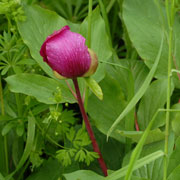
|
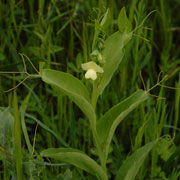
|
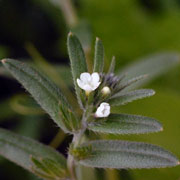
|
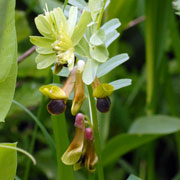
|
| Paeonia mascula A Paeony | Lathyrus ochrus No English name | Lithospermum arvense Field Gromwell | Vicia melanops No English name |


